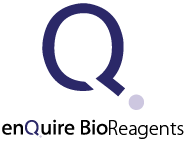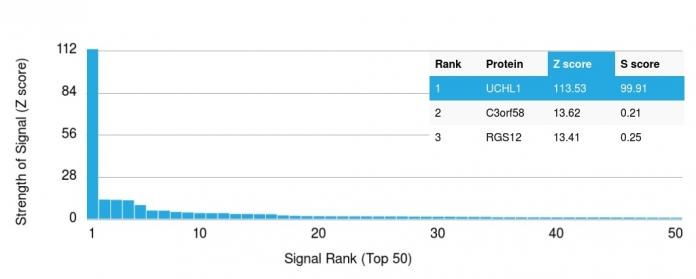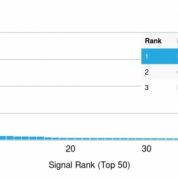Human and Rat. Shows a broad species reactivity. Anti-PGP9.5 / UchL1 (pan-Neuronal Marker) Antibody Product Attributes
Species: Human and Rat. Shows a broad species reactivity.
Tested Applications: WB, IHC.
Clonality: Monoclonal
Anti-PGP9.5 / UchL1 (pan-Neuronal Marker) Antibody Clone: rUCHL1/775
Clone rUCHL1/775 Host and Isotype: Mouse IgG1, kappa
Anti-Human and Rat. Shows a broad species reactivity. PGP9.5 / UchL1 (pan-Neuronal Marker) Positive Control Sample: Cerebellum
Cellular Localization of Antibody rUCHL1/775 Staining: Cytoplasmic. Endoplasmic Reticulum membrane
Buffer and Stabilizer: 10mM PBS with 0.05% BSA & 0.05% azide. Also available without BSA & Azide.
Antibody Concentration: 200 ug/ml
Antibody Purification Method:Protein A/G purified from Bioreactor concentrate.
Immunogen: Recombinant full-length human UCHL1 protein
Storage Conditions: Store at 2 to 8 C (refrigerate). Stable for 24 months when properly stored.
PGP9.5 / UchL1 (pan-Neuronal Marker) Previously Observed Antibody Staining Patterns
Observed Subcellular, Organelle Specific Staining Data:
Anti-UCHL1 antibody staining is expected to be primarily localized to the cytosol and nucleoplasm. There is variability in either the signal strength or the localization of signal in cytosol from cell to cell.Observed Antibody Staining Data By Tissue Type:
Variations in PGP9.5 / UchL1 antibody staining intensity in immunohistochemistry on tissue sections are present across different anatomical locations. An intense signal was observed in neuronal cells in the caudate nucleus, cells in the molecular layer in cerebellum, Purkinje cells in the cerebellum, neuronal cells in the cerebral cortex, peripheral nerve/ganglion in colon, neuronal cells in the hippocampus, cells in the tubules in kidney and islets of Langerhans in pancreas. More moderate antibody staining intensity was present in neuronal cells in the caudate nucleus, cells in the molecular layer in cerebellum, Purkinje cells in the cerebellum, neuronal cells in the cerebral cortex, peripheral nerve/ganglion in colon, neuronal cells in the hippocampus, cells in the tubules in kidney and islets of Langerhans in pancreas. Low, but measureable presence of PGP9.5 / UchL1 could be seen in cells in the seminiferous ducts in testis and Leydig cells in the testis. We were unable to detect PGP9.5 / UchL1 in other tissues. Disease states, inflammation, and other physiological changes can have a substantial impact on antibody staining patterns. These measurements were all taken in tissues deemed normal or from patients without known disease.Observed Antibody Staining Data By Tissue Disease Status:
Tissues from cancer patients, for instance, have their own distinct pattern of PGP9.5 / UchL1 expression as measured by anti-PGP9.5 / UchL1 antibody immunohistochemical staining. The average level of expression by tumor is summarized in the table below. The variability row represents patient to patient variability in IHC staining.| Sample Type | breast cancer | carcinoid | cervical cancer | colorectal cancer | endometrial cancer | glioma | head and neck cancer | liver cancer | lung cancer | lymphoma | melanoma | ovarian cancer | pancreatic cancer | prostate cancer | renal cancer | skin cancer | stomach cancer | testicular cancer | thyroid cancer | urothelial cancer |
|---|---|---|---|---|---|---|---|---|---|---|---|---|---|---|---|---|---|---|---|---|
| Signal Intensity | - | + | - | - | - | + | - | - | - | - | - | - | - | - | - | - | - | - | - | - |
| UCHL1 Variability | + | +++ | + | + | + | ++ | + | + | ++ | + | + | + | + | + | + | + | + | ++ | + | + |
Limitations and Warranty
enQuire Bio's product, PGP9.5 / UchL1 (pan-Neuronal Marker) MonoSpecific Antibody, is available for Research Use Only (RUO-Only). This antibody is guaranteed to work for a period of two years when properly stored.







There are no reviews yet.